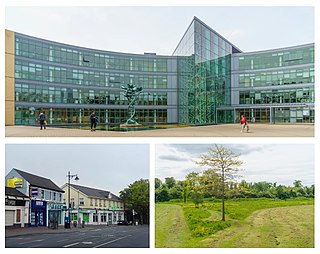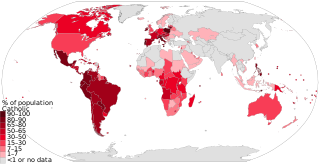
The pope, also known as supreme pontiff, Roman pontiff or sovereign pontiff, is the bishop of Rome, head of the worldwide Catholic Church, and head of state or sovereign of the Vatican City State. From a Catholic viewpoint, the primacy of the bishop of Rome is largely derived from his role as the apostolic successor to Saint Peter, to whom primacy was conferred by Jesus, who gave Peter the Keys of Heaven and the powers of "binding and loosing", naming him as the "rock" upon which the Church would be built. The current pope is Francis, who was elected on 13 March 2013.

Windhoek is the capital and largest city of Namibia. It is located in central Namibia in the Khomas Highland plateau area, at around 1,700 metres (5,600 ft) above sea level, almost exactly at the country's geographical centre. The population of Windhoek in 2020 was 431,000 which is growing continually due to an influx from all over Namibia.

The Catholic Church, also known as the Roman Catholic Church, is the largest Christian church, with 1.3 billion baptised Catholics worldwide as of 2019. As the world's oldest and largest continuously functioning international institution, it has played a prominent role in the history and development of Western civilisation. The church consists of 24 particular churches and almost 3,500 dioceses and eparchies around the world. The pope, who is the bishop of Rome, is the chief pastor of the church. The bishopric of Rome, known as the Holy See, is the central governing authority of the church. The administrative body of the Holy See, the Roman Curia, has its principal offices in Vatican City, a small enclave of Rome, of which the pope is head of state.

Blanchardstown is a large outer suburb of Dublin in the modern county of Fingal, Ireland. Located ten kilometres (6 mi) northwest of Dublin city centre, it has developed since the 1960s from a small village to a point where Greater Blanchardstown is the largest urban area in Fingal.

The Catholic Church is "the Catholic Communion of Churches, both Roman and Eastern, or Oriental, that are in full communion with the Holy See." The church is also known by members as the People of God, the Body of Christ, the "Temple of the Holy Spirit", among other names. According to Vatican II's Gaudium et spes, the "church has but one sole purpose–that the kingdom of God may come and the salvation of the human race may be accomplished."

Fort Portal or Kabarole is a "Tourism city of Uganda", located in the Western Region of the country. It is the seat of both Kabarole District and the Toro Kingdom.
Maximos IV Sayegh was Patriarch of Antioch and All the East, and Alexandria and Jerusalem of the Melkite Greek Catholic Church from 1947 until his death in 1967. One of the fathers of Second Vatican Council, the outspoken patriarch stirred the Council by urging reconciliation between the Catholic and Eastern Orthodox churches. He accepted the title of cardinal in 1965 after Pope Paul VI clarified the significance of that title in the case of an Eastern Patriarch.

The Roman Catholic Metropolitan Archdiocese of Lahore is a Latin Metropolitan Archdiocese in Punjab province, Pakistan.
The Roman Catholic Archdiocese of Windhoek is the Metropolitan See for the Ecclesiastical province of Windhoek in Namibia. The predecessor to the current Archdiocese, the Prefecture Apostolic of Cimbebasia, was established in 1892 and the current archdiocese was fully erected in March 1994. The current archbishop is Liborius Ndumbukuti Nashenda.
Religion in Namibia is dominated by various branches of Christianity, with more than 90 percent of Namibian citizens identifying themselves as Christian. According to the United States DRL, in 2007 up to 75% were Protestant, including as much as 50% Lutheran.
Reverend Dr Kaptein Hendrik Witbooi was a Namibian politician and the seventh Captain of the ǀKhowesin clan. A member of SWAPO from 1976 until his death, Witbooi brought with him several clans of Namaqua into the liberation organisation.

Oshikuku is a town in Omusati Region in the north of Namibia. It is the district capital of Oshikuku Constituency.
Andara is a village in Mukwe Constituency in the Kavango East region of north-eastern Namibia. Located 200 kilometres (120 mi) east of Rundu, it is inhabited primarily by the Hambukushu people.

The Personal Ordinariate of Our Lady of Walsingham in England and Wales is a personal ordinariate in the Latin Church of the Catholic Church immediately exempt to the Holy See within the territory of the Catholic Bishops' Conference of England and Wales, of which its ordinary is a member, and encompassing Scotland also. It was established on 15 January 2011 for groups of former Anglicans in England and Wales in accordance with the apostolic constitution Anglicanorum coetibus of Pope Benedict XVI.
Bonifatius Haushiku or Hausiku was a Namibian Roman Catholic religious leader.
Nyangana is a village in the Ndiyona Constituency in Kavango East Region of north-eastern Namibia, situated 100 kilometres (62 mi) east of Rundu. The Roman Catholic mission of Nyangana is located in the village.

Epukiro is a cluster of small settlements in the remote eastern part of the Omaheke Region of Namibia, situated about 120 kilometres (75 mi) northeast of the regional capital Gobabis. The centre of the populated area is the Catholic mission station. Epukiro had about 3,200 inhabitants in 1997, predominantly ethnic Tswana.

Aminuis is a cluster of small settlements in the remote eastern part of the Omaheke Region of Namibia, located about 500 km east of Windhoek. It is the district capital of the Aminuis electoral constituency.
Lutheranism was first introduced to Angola in the late 1800s, when Finnish missionaries began working in northern Namibia and southern Angola. Following the Portuguese defeat of Mandume Ya Ndemufayo in 1917, the Lutheran church in Angola was repressed by the Roman Catholic Portuguese authorities. In 1956, Lutheranism was reestablished in Angola, and in 1991, the Evangelical Lutheran Church of Angola was organized as an independent church body. In 1997, a smaller group of conservative Lutheran missionaries helped to organize a second Angolan Lutheran church: the Confessional Lutheran Church in Angola.
Döbra is a settlement about 25 kilometres (16 mi) north of the capital Windhoek.











